System Development Report: System Development for Greenwich Rose Hotel
VerifiedAdded on 2020/10/23
|16
|4562
|139
Report
AI Summary
This report provides a comprehensive analysis of system development methodologies, focusing on the application of different System Development Life Cycle (SDLC) models within the context of the Greenwich Rose Hotel (GRH). The report begins by exploring various SDLC models, including Waterfall, V-shaped, RAD, Spiral, and Agile, assessing their suitability for the hotel's needs. It then emphasizes the importance of following a procedural/staged life cycle during system investigations, highlighting how it aids in identifying customer requirements and designing effective software solutions. The report delves into the components of a feasibility report, outlining its significance in determining project scope and assessing the current state of the GRH's operations. Furthermore, it underscores the importance of conducting feasibility analysis before project initiation, considering technical and economic aspects. The report also includes a system investigation to meet a business need, modeling the data view using an Entity-Relationship Diagram (ERD) and visualizing the proposed system with a Data Flow Diagram (DFD). Finally, it provides documentation supporting the system investigation and evaluates how the solution addresses system and user requirements, concluding with recommendations for system implementation in the hotel.
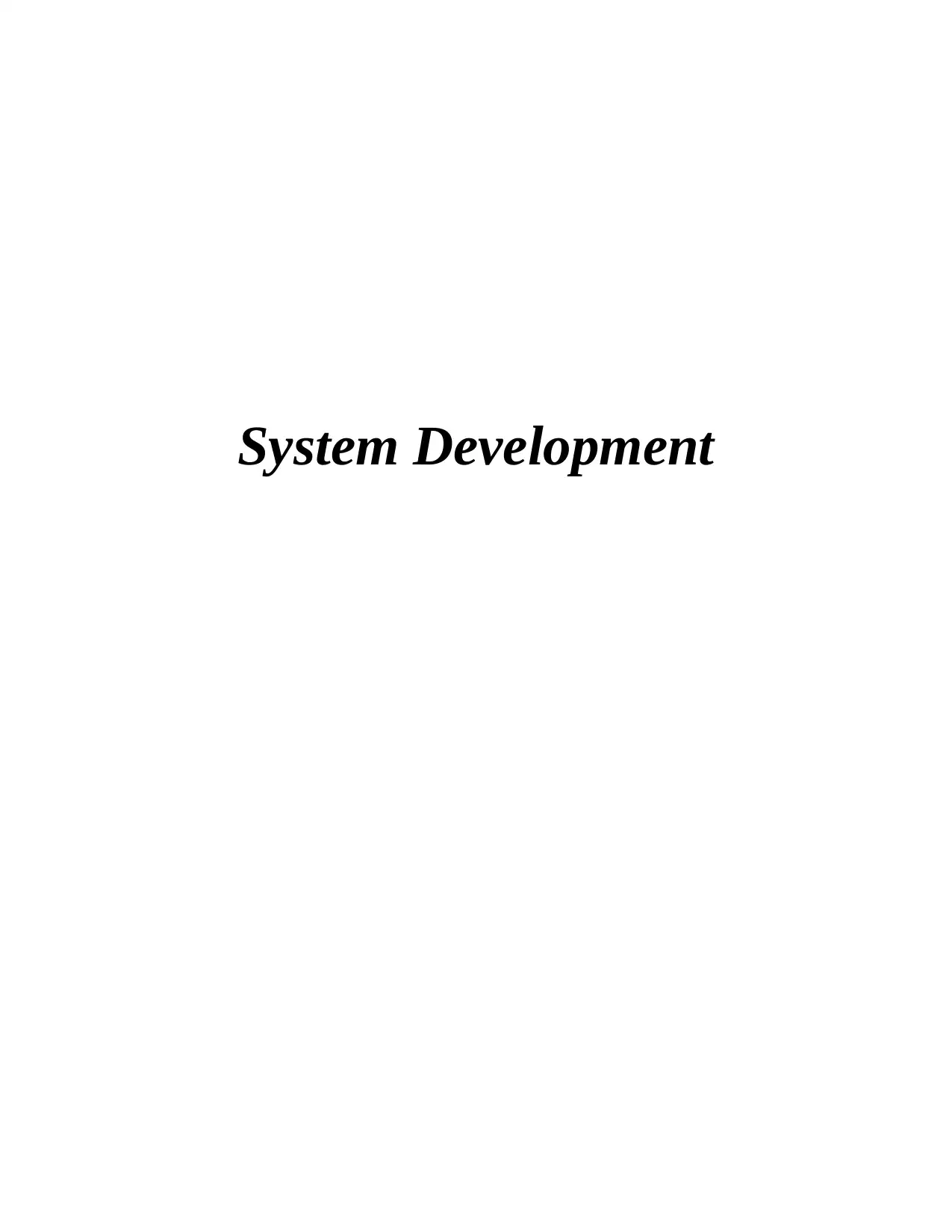
System Development
Paraphrase This Document
Need a fresh take? Get an instant paraphrase of this document with our AI Paraphraser
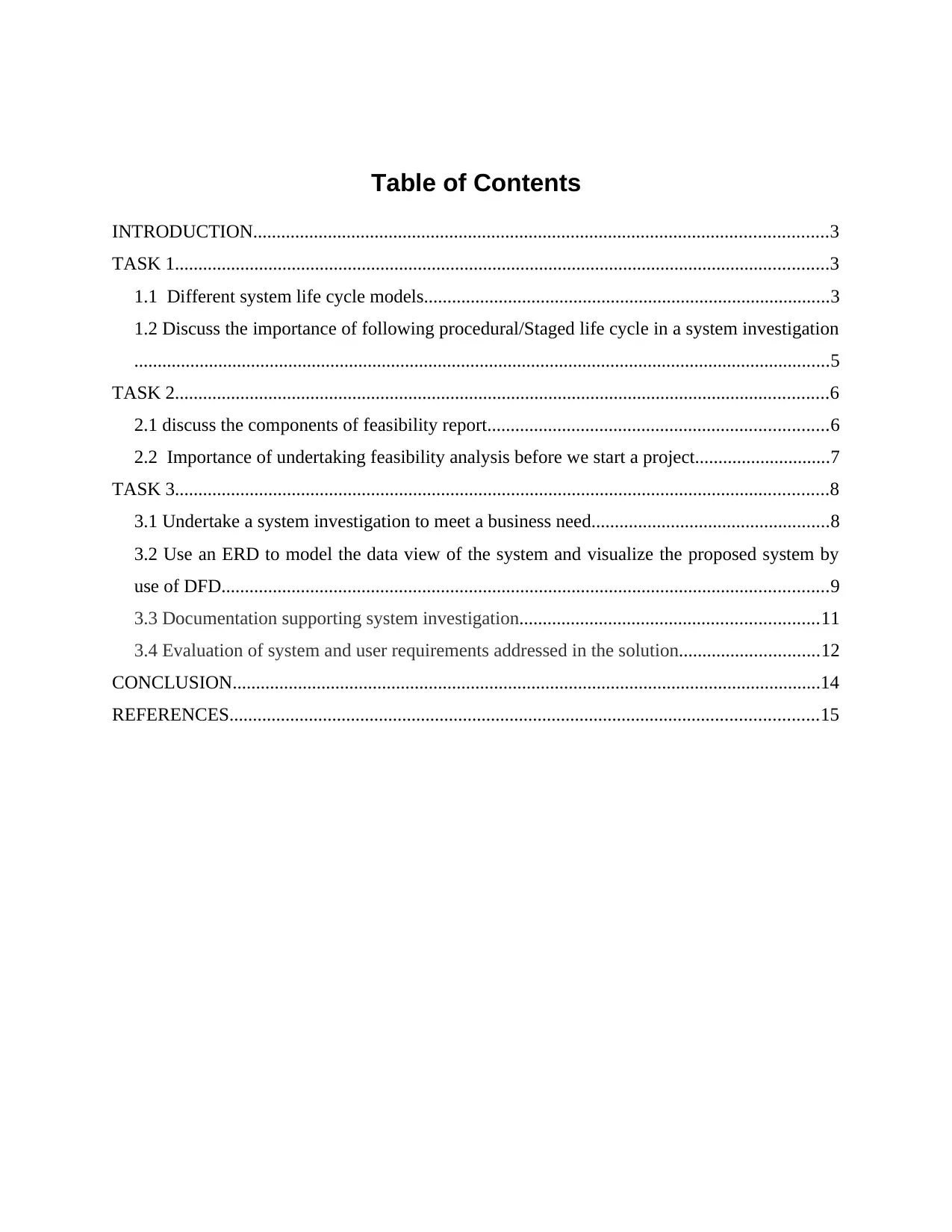
Table of Contents
INTRODUCTION...........................................................................................................................3
TASK 1............................................................................................................................................3
1.1 Different system life cycle models.......................................................................................3
1.2 Discuss the importance of following procedural/Staged life cycle in a system investigation
.....................................................................................................................................................5
TASK 2............................................................................................................................................6
2.1 discuss the components of feasibility report.........................................................................6
2.2 Importance of undertaking feasibility analysis before we start a project.............................7
TASK 3............................................................................................................................................8
3.1 Undertake a system investigation to meet a business need...................................................8
3.2 Use an ERD to model the data view of the system and visualize the proposed system by
use of DFD..................................................................................................................................9
3.3 Documentation supporting system investigation................................................................11
3.4 Evaluation of system and user requirements addressed in the solution..............................12
CONCLUSION..............................................................................................................................14
REFERENCES..............................................................................................................................15
INTRODUCTION...........................................................................................................................3
TASK 1............................................................................................................................................3
1.1 Different system life cycle models.......................................................................................3
1.2 Discuss the importance of following procedural/Staged life cycle in a system investigation
.....................................................................................................................................................5
TASK 2............................................................................................................................................6
2.1 discuss the components of feasibility report.........................................................................6
2.2 Importance of undertaking feasibility analysis before we start a project.............................7
TASK 3............................................................................................................................................8
3.1 Undertake a system investigation to meet a business need...................................................8
3.2 Use an ERD to model the data view of the system and visualize the proposed system by
use of DFD..................................................................................................................................9
3.3 Documentation supporting system investigation................................................................11
3.4 Evaluation of system and user requirements addressed in the solution..............................12
CONCLUSION..............................................................................................................................14
REFERENCES..............................................................................................................................15
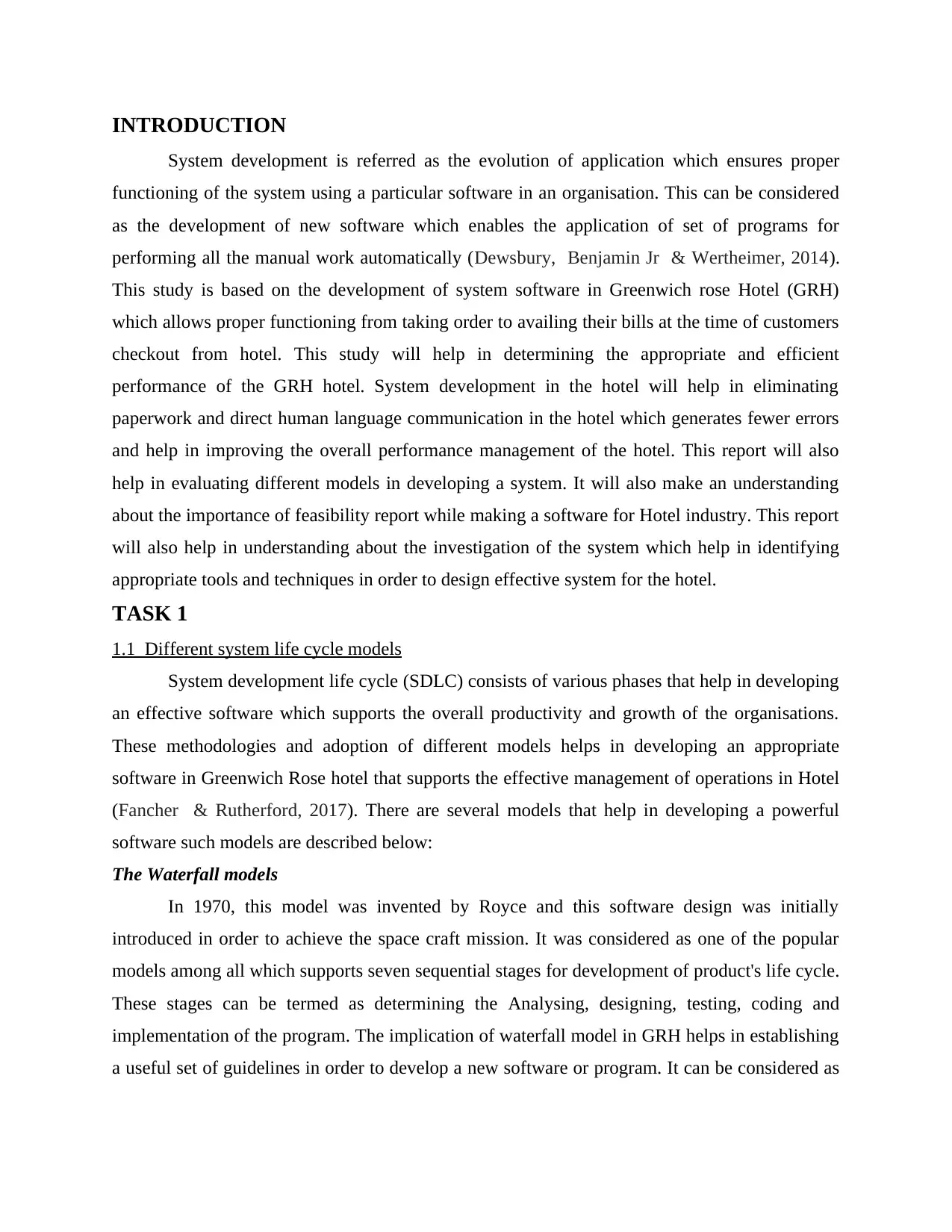
INTRODUCTION
System development is referred as the evolution of application which ensures proper
functioning of the system using a particular software in an organisation. This can be considered
as the development of new software which enables the application of set of programs for
performing all the manual work automatically (Dewsbury, Benjamin Jr & Wertheimer, 2014).
This study is based on the development of system software in Greenwich rose Hotel (GRH)
which allows proper functioning from taking order to availing their bills at the time of customers
checkout from hotel. This study will help in determining the appropriate and efficient
performance of the GRH hotel. System development in the hotel will help in eliminating
paperwork and direct human language communication in the hotel which generates fewer errors
and help in improving the overall performance management of the hotel. This report will also
help in evaluating different models in developing a system. It will also make an understanding
about the importance of feasibility report while making a software for Hotel industry. This report
will also help in understanding about the investigation of the system which help in identifying
appropriate tools and techniques in order to design effective system for the hotel.
TASK 1
1.1 Different system life cycle models
System development life cycle (SDLC) consists of various phases that help in developing
an effective software which supports the overall productivity and growth of the organisations.
These methodologies and adoption of different models helps in developing an appropriate
software in Greenwich Rose hotel that supports the effective management of operations in Hotel
(Fancher & Rutherford, 2017). There are several models that help in developing a powerful
software such models are described below:
The Waterfall models
In 1970, this model was invented by Royce and this software design was initially
introduced in order to achieve the space craft mission. It was considered as one of the popular
models among all which supports seven sequential stages for development of product's life cycle.
These stages can be termed as determining the Analysing, designing, testing, coding and
implementation of the program. The implication of waterfall model in GRH helps in establishing
a useful set of guidelines in order to develop a new software or program. It can be considered as
System development is referred as the evolution of application which ensures proper
functioning of the system using a particular software in an organisation. This can be considered
as the development of new software which enables the application of set of programs for
performing all the manual work automatically (Dewsbury, Benjamin Jr & Wertheimer, 2014).
This study is based on the development of system software in Greenwich rose Hotel (GRH)
which allows proper functioning from taking order to availing their bills at the time of customers
checkout from hotel. This study will help in determining the appropriate and efficient
performance of the GRH hotel. System development in the hotel will help in eliminating
paperwork and direct human language communication in the hotel which generates fewer errors
and help in improving the overall performance management of the hotel. This report will also
help in evaluating different models in developing a system. It will also make an understanding
about the importance of feasibility report while making a software for Hotel industry. This report
will also help in understanding about the investigation of the system which help in identifying
appropriate tools and techniques in order to design effective system for the hotel.
TASK 1
1.1 Different system life cycle models
System development life cycle (SDLC) consists of various phases that help in developing
an effective software which supports the overall productivity and growth of the organisations.
These methodologies and adoption of different models helps in developing an appropriate
software in Greenwich Rose hotel that supports the effective management of operations in Hotel
(Fancher & Rutherford, 2017). There are several models that help in developing a powerful
software such models are described below:
The Waterfall models
In 1970, this model was invented by Royce and this software design was initially
introduced in order to achieve the space craft mission. It was considered as one of the popular
models among all which supports seven sequential stages for development of product's life cycle.
These stages can be termed as determining the Analysing, designing, testing, coding and
implementation of the program. The implication of waterfall model in GRH helps in establishing
a useful set of guidelines in order to develop a new software or program. It can be considered as
⊘ This is a preview!⊘
Do you want full access?
Subscribe today to unlock all pages.

Trusted by 1+ million students worldwide
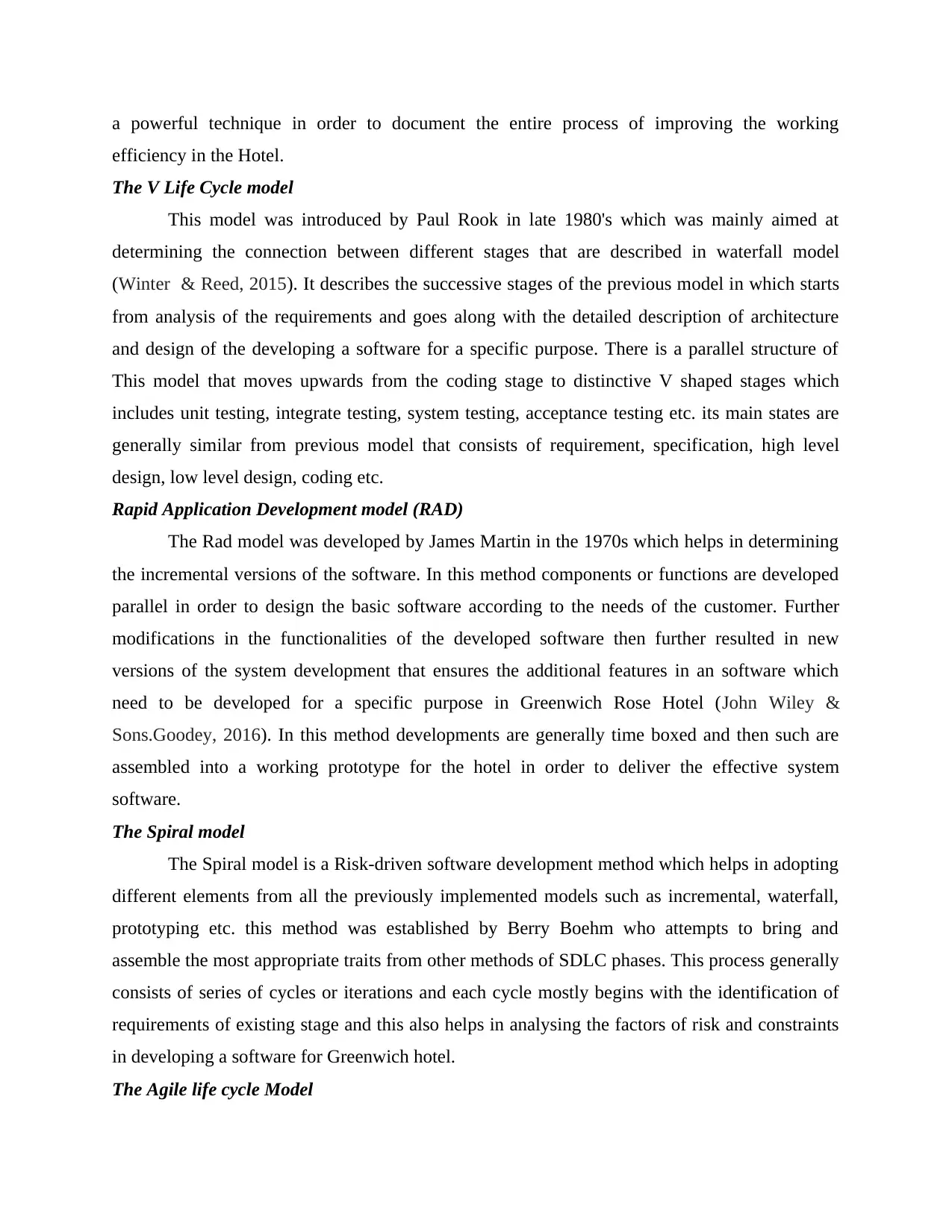
a powerful technique in order to document the entire process of improving the working
efficiency in the Hotel.
The V Life Cycle model
This model was introduced by Paul Rook in late 1980's which was mainly aimed at
determining the connection between different stages that are described in waterfall model
(Winter & Reed, 2015). It describes the successive stages of the previous model in which starts
from analysis of the requirements and goes along with the detailed description of architecture
and design of the developing a software for a specific purpose. There is a parallel structure of
This model that moves upwards from the coding stage to distinctive V shaped stages which
includes unit testing, integrate testing, system testing, acceptance testing etc. its main states are
generally similar from previous model that consists of requirement, specification, high level
design, low level design, coding etc.
Rapid Application Development model (RAD)
The Rad model was developed by James Martin in the 1970s which helps in determining
the incremental versions of the software. In this method components or functions are developed
parallel in order to design the basic software according to the needs of the customer. Further
modifications in the functionalities of the developed software then further resulted in new
versions of the system development that ensures the additional features in an software which
need to be developed for a specific purpose in Greenwich Rose Hotel (John Wiley &
Sons.Goodey, 2016). In this method developments are generally time boxed and then such are
assembled into a working prototype for the hotel in order to deliver the effective system
software.
The Spiral model
The Spiral model is a Risk-driven software development method which helps in adopting
different elements from all the previously implemented models such as incremental, waterfall,
prototyping etc. this method was established by Berry Boehm who attempts to bring and
assemble the most appropriate traits from other methods of SDLC phases. This process generally
consists of series of cycles or iterations and each cycle mostly begins with the identification of
requirements of existing stage and this also helps in analysing the factors of risk and constraints
in developing a software for Greenwich hotel.
The Agile life cycle Model
efficiency in the Hotel.
The V Life Cycle model
This model was introduced by Paul Rook in late 1980's which was mainly aimed at
determining the connection between different stages that are described in waterfall model
(Winter & Reed, 2015). It describes the successive stages of the previous model in which starts
from analysis of the requirements and goes along with the detailed description of architecture
and design of the developing a software for a specific purpose. There is a parallel structure of
This model that moves upwards from the coding stage to distinctive V shaped stages which
includes unit testing, integrate testing, system testing, acceptance testing etc. its main states are
generally similar from previous model that consists of requirement, specification, high level
design, low level design, coding etc.
Rapid Application Development model (RAD)
The Rad model was developed by James Martin in the 1970s which helps in determining
the incremental versions of the software. In this method components or functions are developed
parallel in order to design the basic software according to the needs of the customer. Further
modifications in the functionalities of the developed software then further resulted in new
versions of the system development that ensures the additional features in an software which
need to be developed for a specific purpose in Greenwich Rose Hotel (John Wiley &
Sons.Goodey, 2016). In this method developments are generally time boxed and then such are
assembled into a working prototype for the hotel in order to deliver the effective system
software.
The Spiral model
The Spiral model is a Risk-driven software development method which helps in adopting
different elements from all the previously implemented models such as incremental, waterfall,
prototyping etc. this method was established by Berry Boehm who attempts to bring and
assemble the most appropriate traits from other methods of SDLC phases. This process generally
consists of series of cycles or iterations and each cycle mostly begins with the identification of
requirements of existing stage and this also helps in analysing the factors of risk and constraints
in developing a software for Greenwich hotel.
The Agile life cycle Model
Paraphrase This Document
Need a fresh take? Get an instant paraphrase of this document with our AI Paraphraser
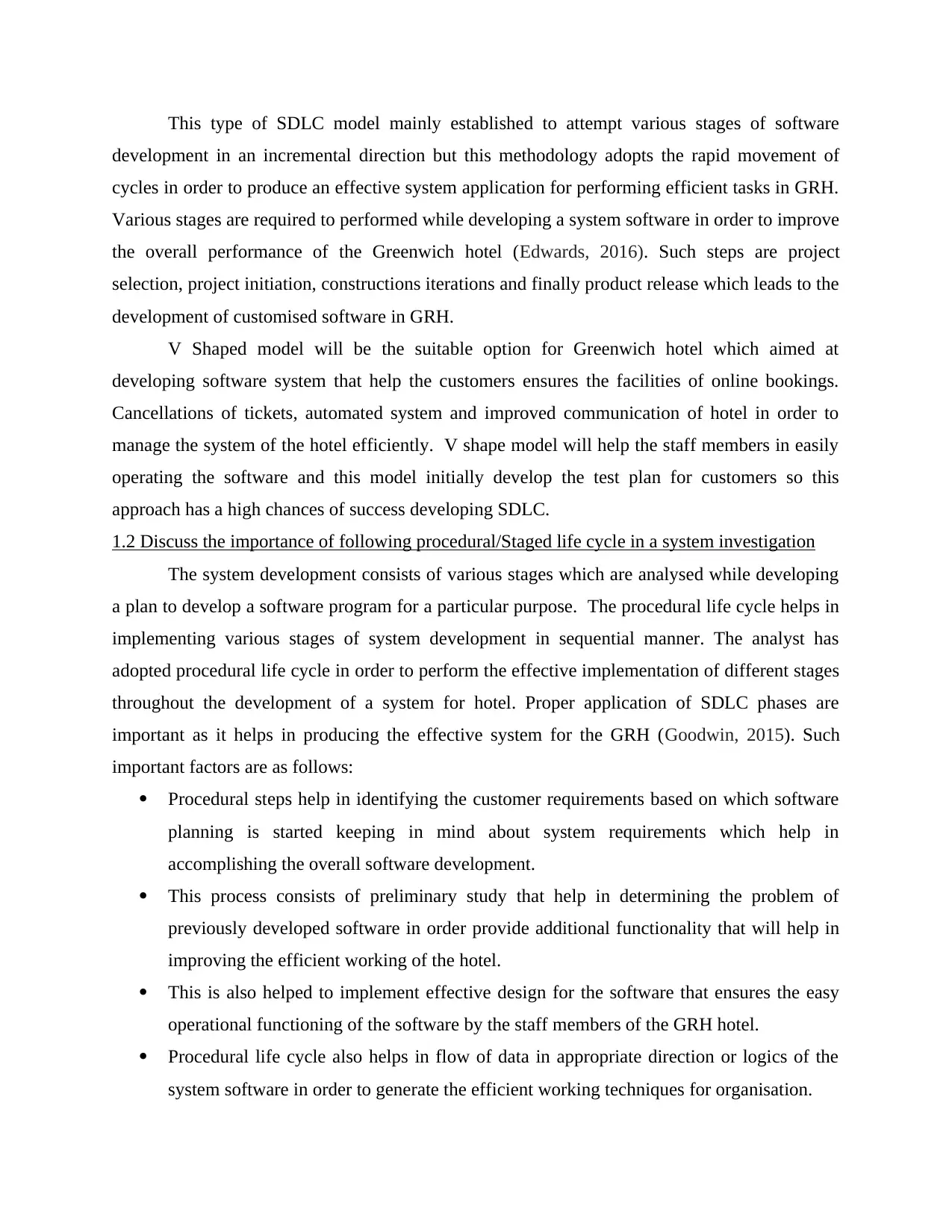
This type of SDLC model mainly established to attempt various stages of software
development in an incremental direction but this methodology adopts the rapid movement of
cycles in order to produce an effective system application for performing efficient tasks in GRH.
Various stages are required to performed while developing a system software in order to improve
the overall performance of the Greenwich hotel (Edwards, 2016). Such steps are project
selection, project initiation, constructions iterations and finally product release which leads to the
development of customised software in GRH.
V Shaped model will be the suitable option for Greenwich hotel which aimed at
developing software system that help the customers ensures the facilities of online bookings.
Cancellations of tickets, automated system and improved communication of hotel in order to
manage the system of the hotel efficiently. V shape model will help the staff members in easily
operating the software and this model initially develop the test plan for customers so this
approach has a high chances of success developing SDLC.
1.2 Discuss the importance of following procedural/Staged life cycle in a system investigation
The system development consists of various stages which are analysed while developing
a plan to develop a software program for a particular purpose. The procedural life cycle helps in
implementing various stages of system development in sequential manner. The analyst has
adopted procedural life cycle in order to perform the effective implementation of different stages
throughout the development of a system for hotel. Proper application of SDLC phases are
important as it helps in producing the effective system for the GRH (Goodwin, 2015). Such
important factors are as follows:
Procedural steps help in identifying the customer requirements based on which software
planning is started keeping in mind about system requirements which help in
accomplishing the overall software development.
This process consists of preliminary study that help in determining the problem of
previously developed software in order provide additional functionality that will help in
improving the efficient working of the hotel.
This is also helped to implement effective design for the software that ensures the easy
operational functioning of the software by the staff members of the GRH hotel.
Procedural life cycle also helps in flow of data in appropriate direction or logics of the
system software in order to generate the efficient working techniques for organisation.
development in an incremental direction but this methodology adopts the rapid movement of
cycles in order to produce an effective system application for performing efficient tasks in GRH.
Various stages are required to performed while developing a system software in order to improve
the overall performance of the Greenwich hotel (Edwards, 2016). Such steps are project
selection, project initiation, constructions iterations and finally product release which leads to the
development of customised software in GRH.
V Shaped model will be the suitable option for Greenwich hotel which aimed at
developing software system that help the customers ensures the facilities of online bookings.
Cancellations of tickets, automated system and improved communication of hotel in order to
manage the system of the hotel efficiently. V shape model will help the staff members in easily
operating the software and this model initially develop the test plan for customers so this
approach has a high chances of success developing SDLC.
1.2 Discuss the importance of following procedural/Staged life cycle in a system investigation
The system development consists of various stages which are analysed while developing
a plan to develop a software program for a particular purpose. The procedural life cycle helps in
implementing various stages of system development in sequential manner. The analyst has
adopted procedural life cycle in order to perform the effective implementation of different stages
throughout the development of a system for hotel. Proper application of SDLC phases are
important as it helps in producing the effective system for the GRH (Goodwin, 2015). Such
important factors are as follows:
Procedural steps help in identifying the customer requirements based on which software
planning is started keeping in mind about system requirements which help in
accomplishing the overall software development.
This process consists of preliminary study that help in determining the problem of
previously developed software in order provide additional functionality that will help in
improving the efficient working of the hotel.
This is also helped to implement effective design for the software that ensures the easy
operational functioning of the software by the staff members of the GRH hotel.
Procedural life cycle also helps in flow of data in appropriate direction or logics of the
system software in order to generate the efficient working techniques for organisation.
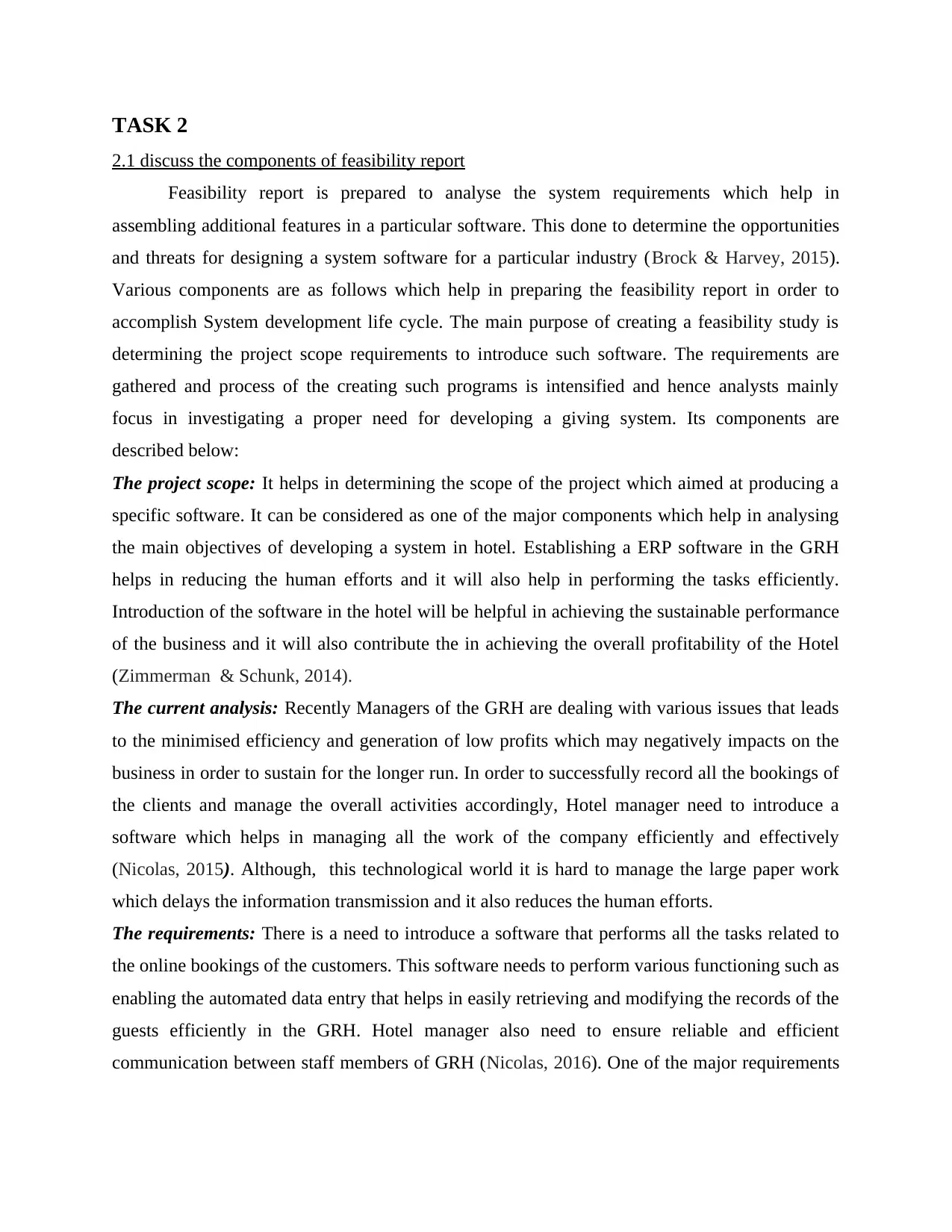
TASK 2
2.1 discuss the components of feasibility report
Feasibility report is prepared to analyse the system requirements which help in
assembling additional features in a particular software. This done to determine the opportunities
and threats for designing a system software for a particular industry (Brock & Harvey, 2015).
Various components are as follows which help in preparing the feasibility report in order to
accomplish System development life cycle. The main purpose of creating a feasibility study is
determining the project scope requirements to introduce such software. The requirements are
gathered and process of the creating such programs is intensified and hence analysts mainly
focus in investigating a proper need for developing a giving system. Its components are
described below:
The project scope: It helps in determining the scope of the project which aimed at producing a
specific software. It can be considered as one of the major components which help in analysing
the main objectives of developing a system in hotel. Establishing a ERP software in the GRH
helps in reducing the human efforts and it will also help in performing the tasks efficiently.
Introduction of the software in the hotel will be helpful in achieving the sustainable performance
of the business and it will also contribute the in achieving the overall profitability of the Hotel
(Zimmerman & Schunk, 2014).
The current analysis: Recently Managers of the GRH are dealing with various issues that leads
to the minimised efficiency and generation of low profits which may negatively impacts on the
business in order to sustain for the longer run. In order to successfully record all the bookings of
the clients and manage the overall activities accordingly, Hotel manager need to introduce a
software which helps in managing all the work of the company efficiently and effectively
(Nicolas, 2015). Although, this technological world it is hard to manage the large paper work
which delays the information transmission and it also reduces the human efforts.
The requirements: There is a need to introduce a software that performs all the tasks related to
the online bookings of the customers. This software needs to perform various functioning such as
enabling the automated data entry that helps in easily retrieving and modifying the records of the
guests efficiently in the GRH. Hotel manager also need to ensure reliable and efficient
communication between staff members of GRH (Nicolas, 2016). One of the major requirements
2.1 discuss the components of feasibility report
Feasibility report is prepared to analyse the system requirements which help in
assembling additional features in a particular software. This done to determine the opportunities
and threats for designing a system software for a particular industry (Brock & Harvey, 2015).
Various components are as follows which help in preparing the feasibility report in order to
accomplish System development life cycle. The main purpose of creating a feasibility study is
determining the project scope requirements to introduce such software. The requirements are
gathered and process of the creating such programs is intensified and hence analysts mainly
focus in investigating a proper need for developing a giving system. Its components are
described below:
The project scope: It helps in determining the scope of the project which aimed at producing a
specific software. It can be considered as one of the major components which help in analysing
the main objectives of developing a system in hotel. Establishing a ERP software in the GRH
helps in reducing the human efforts and it will also help in performing the tasks efficiently.
Introduction of the software in the hotel will be helpful in achieving the sustainable performance
of the business and it will also contribute the in achieving the overall profitability of the Hotel
(Zimmerman & Schunk, 2014).
The current analysis: Recently Managers of the GRH are dealing with various issues that leads
to the minimised efficiency and generation of low profits which may negatively impacts on the
business in order to sustain for the longer run. In order to successfully record all the bookings of
the clients and manage the overall activities accordingly, Hotel manager need to introduce a
software which helps in managing all the work of the company efficiently and effectively
(Nicolas, 2015). Although, this technological world it is hard to manage the large paper work
which delays the information transmission and it also reduces the human efforts.
The requirements: There is a need to introduce a software that performs all the tasks related to
the online bookings of the customers. This software needs to perform various functioning such as
enabling the automated data entry that helps in easily retrieving and modifying the records of the
guests efficiently in the GRH. Hotel manager also need to ensure reliable and efficient
communication between staff members of GRH (Nicolas, 2016). One of the major requirements
⊘ This is a preview!⊘
Do you want full access?
Subscribe today to unlock all pages.

Trusted by 1+ million students worldwide
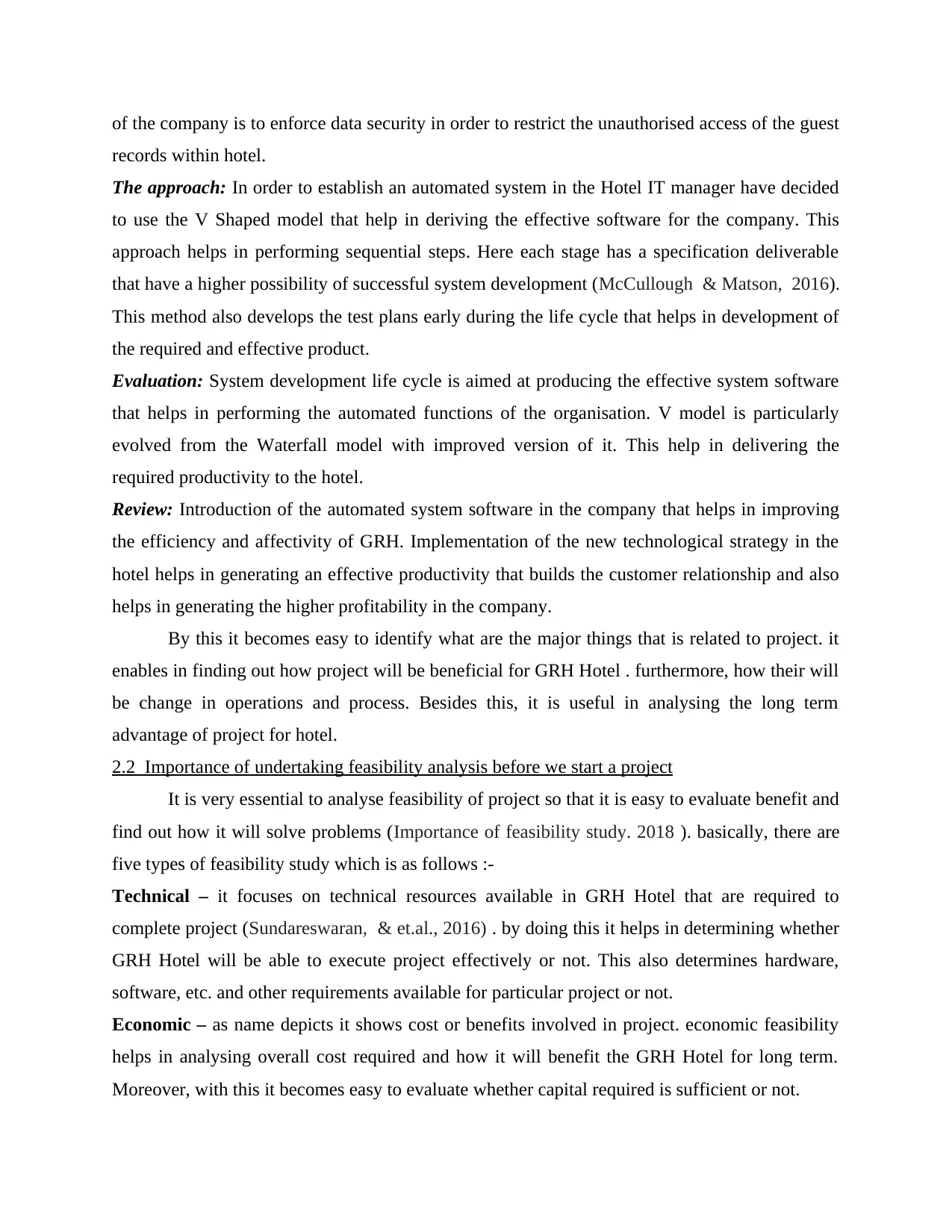
of the company is to enforce data security in order to restrict the unauthorised access of the guest
records within hotel.
The approach: In order to establish an automated system in the Hotel IT manager have decided
to use the V Shaped model that help in deriving the effective software for the company. This
approach helps in performing sequential steps. Here each stage has a specification deliverable
that have a higher possibility of successful system development (McCullough & Matson, 2016).
This method also develops the test plans early during the life cycle that helps in development of
the required and effective product.
Evaluation: System development life cycle is aimed at producing the effective system software
that helps in performing the automated functions of the organisation. V model is particularly
evolved from the Waterfall model with improved version of it. This help in delivering the
required productivity to the hotel.
Review: Introduction of the automated system software in the company that helps in improving
the efficiency and affectivity of GRH. Implementation of the new technological strategy in the
hotel helps in generating an effective productivity that builds the customer relationship and also
helps in generating the higher profitability in the company.
By this it becomes easy to identify what are the major things that is related to project. it
enables in finding out how project will be beneficial for GRH Hotel . furthermore, how their will
be change in operations and process. Besides this, it is useful in analysing the long term
advantage of project for hotel.
2.2 Importance of undertaking feasibility analysis before we start a project
It is very essential to analyse feasibility of project so that it is easy to evaluate benefit and
find out how it will solve problems (Importance of feasibility study. 2018 ). basically, there are
five types of feasibility study which is as follows :-
Technical – it focuses on technical resources available in GRH Hotel that are required to
complete project (Sundareswaran, & et.al., 2016) . by doing this it helps in determining whether
GRH Hotel will be able to execute project effectively or not. This also determines hardware,
software, etc. and other requirements available for particular project or not.
Economic – as name depicts it shows cost or benefits involved in project. economic feasibility
helps in analysing overall cost required and how it will benefit the GRH Hotel for long term.
Moreover, with this it becomes easy to evaluate whether capital required is sufficient or not.
records within hotel.
The approach: In order to establish an automated system in the Hotel IT manager have decided
to use the V Shaped model that help in deriving the effective software for the company. This
approach helps in performing sequential steps. Here each stage has a specification deliverable
that have a higher possibility of successful system development (McCullough & Matson, 2016).
This method also develops the test plans early during the life cycle that helps in development of
the required and effective product.
Evaluation: System development life cycle is aimed at producing the effective system software
that helps in performing the automated functions of the organisation. V model is particularly
evolved from the Waterfall model with improved version of it. This help in delivering the
required productivity to the hotel.
Review: Introduction of the automated system software in the company that helps in improving
the efficiency and affectivity of GRH. Implementation of the new technological strategy in the
hotel helps in generating an effective productivity that builds the customer relationship and also
helps in generating the higher profitability in the company.
By this it becomes easy to identify what are the major things that is related to project. it
enables in finding out how project will be beneficial for GRH Hotel . furthermore, how their will
be change in operations and process. Besides this, it is useful in analysing the long term
advantage of project for hotel.
2.2 Importance of undertaking feasibility analysis before we start a project
It is very essential to analyse feasibility of project so that it is easy to evaluate benefit and
find out how it will solve problems (Importance of feasibility study. 2018 ). basically, there are
five types of feasibility study which is as follows :-
Technical – it focuses on technical resources available in GRH Hotel that are required to
complete project (Sundareswaran, & et.al., 2016) . by doing this it helps in determining whether
GRH Hotel will be able to execute project effectively or not. This also determines hardware,
software, etc. and other requirements available for particular project or not.
Economic – as name depicts it shows cost or benefits involved in project. economic feasibility
helps in analysing overall cost required and how it will benefit the GRH Hotel for long term.
Moreover, with this it becomes easy to evaluate whether capital required is sufficient or not.
Paraphrase This Document
Need a fresh take? Get an instant paraphrase of this document with our AI Paraphraser
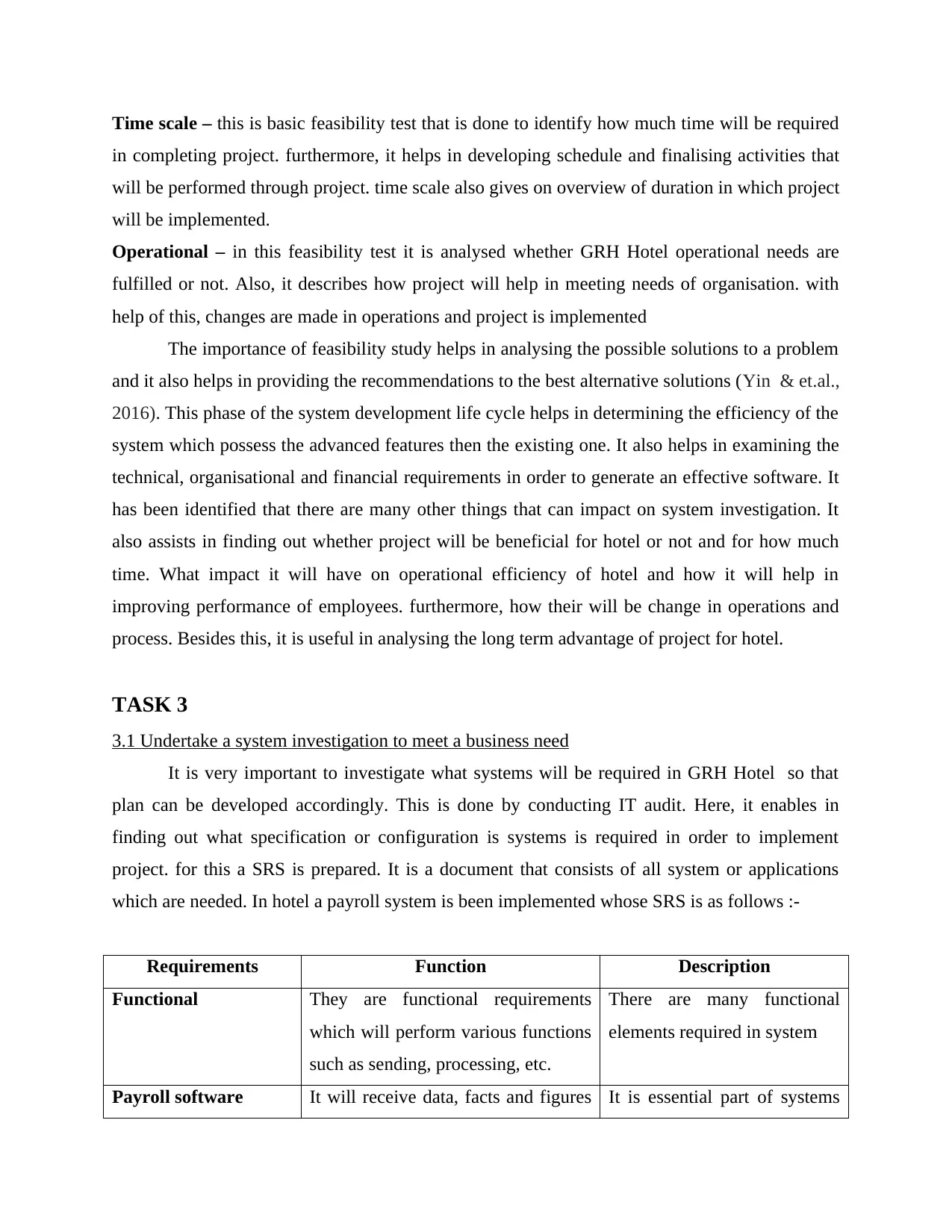
Time scale – this is basic feasibility test that is done to identify how much time will be required
in completing project. furthermore, it helps in developing schedule and finalising activities that
will be performed through project. time scale also gives on overview of duration in which project
will be implemented.
Operational – in this feasibility test it is analysed whether GRH Hotel operational needs are
fulfilled or not. Also, it describes how project will help in meeting needs of organisation. with
help of this, changes are made in operations and project is implemented
The importance of feasibility study helps in analysing the possible solutions to a problem
and it also helps in providing the recommendations to the best alternative solutions (Yin & et.al.,
2016). This phase of the system development life cycle helps in determining the efficiency of the
system which possess the advanced features then the existing one. It also helps in examining the
technical, organisational and financial requirements in order to generate an effective software. It
has been identified that there are many other things that can impact on system investigation. It
also assists in finding out whether project will be beneficial for hotel or not and for how much
time. What impact it will have on operational efficiency of hotel and how it will help in
improving performance of employees. furthermore, how their will be change in operations and
process. Besides this, it is useful in analysing the long term advantage of project for hotel.
TASK 3
3.1 Undertake a system investigation to meet a business need
It is very important to investigate what systems will be required in GRH Hotel so that
plan can be developed accordingly. This is done by conducting IT audit. Here, it enables in
finding out what specification or configuration is systems is required in order to implement
project. for this a SRS is prepared. It is a document that consists of all system or applications
which are needed. In hotel a payroll system is been implemented whose SRS is as follows :-
Requirements Function Description
Functional They are functional requirements
which will perform various functions
such as sending, processing, etc.
There are many functional
elements required in system
Payroll software It will receive data, facts and figures It is essential part of systems
in completing project. furthermore, it helps in developing schedule and finalising activities that
will be performed through project. time scale also gives on overview of duration in which project
will be implemented.
Operational – in this feasibility test it is analysed whether GRH Hotel operational needs are
fulfilled or not. Also, it describes how project will help in meeting needs of organisation. with
help of this, changes are made in operations and project is implemented
The importance of feasibility study helps in analysing the possible solutions to a problem
and it also helps in providing the recommendations to the best alternative solutions (Yin & et.al.,
2016). This phase of the system development life cycle helps in determining the efficiency of the
system which possess the advanced features then the existing one. It also helps in examining the
technical, organisational and financial requirements in order to generate an effective software. It
has been identified that there are many other things that can impact on system investigation. It
also assists in finding out whether project will be beneficial for hotel or not and for how much
time. What impact it will have on operational efficiency of hotel and how it will help in
improving performance of employees. furthermore, how their will be change in operations and
process. Besides this, it is useful in analysing the long term advantage of project for hotel.
TASK 3
3.1 Undertake a system investigation to meet a business need
It is very important to investigate what systems will be required in GRH Hotel so that
plan can be developed accordingly. This is done by conducting IT audit. Here, it enables in
finding out what specification or configuration is systems is required in order to implement
project. for this a SRS is prepared. It is a document that consists of all system or applications
which are needed. In hotel a payroll system is been implemented whose SRS is as follows :-
Requirements Function Description
Functional They are functional requirements
which will perform various functions
such as sending, processing, etc.
There are many functional
elements required in system
Payroll software It will receive data, facts and figures It is essential part of systems
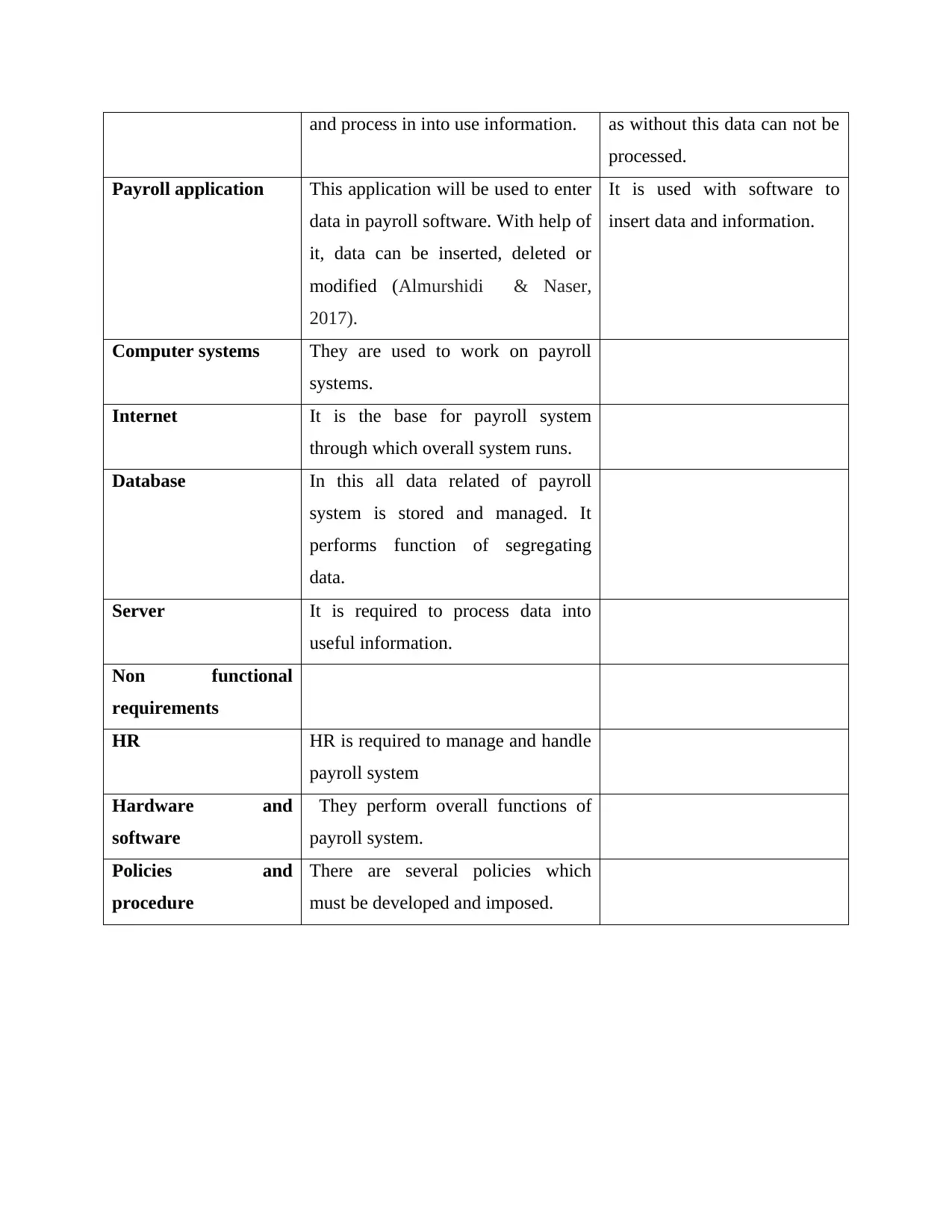
and process in into use information. as without this data can not be
processed.
Payroll application This application will be used to enter
data in payroll software. With help of
it, data can be inserted, deleted or
modified (Almurshidi & Naser,
2017).
It is used with software to
insert data and information.
Computer systems They are used to work on payroll
systems.
Internet It is the base for payroll system
through which overall system runs.
Database In this all data related of payroll
system is stored and managed. It
performs function of segregating
data.
Server It is required to process data into
useful information.
Non functional
requirements
HR HR is required to manage and handle
payroll system
Hardware and
software
They perform overall functions of
payroll system.
Policies and
procedure
There are several policies which
must be developed and imposed.
processed.
Payroll application This application will be used to enter
data in payroll software. With help of
it, data can be inserted, deleted or
modified (Almurshidi & Naser,
2017).
It is used with software to
insert data and information.
Computer systems They are used to work on payroll
systems.
Internet It is the base for payroll system
through which overall system runs.
Database In this all data related of payroll
system is stored and managed. It
performs function of segregating
data.
Server It is required to process data into
useful information.
Non functional
requirements
HR HR is required to manage and handle
payroll system
Hardware and
software
They perform overall functions of
payroll system.
Policies and
procedure
There are several policies which
must be developed and imposed.
⊘ This is a preview!⊘
Do you want full access?
Subscribe today to unlock all pages.

Trusted by 1+ million students worldwide
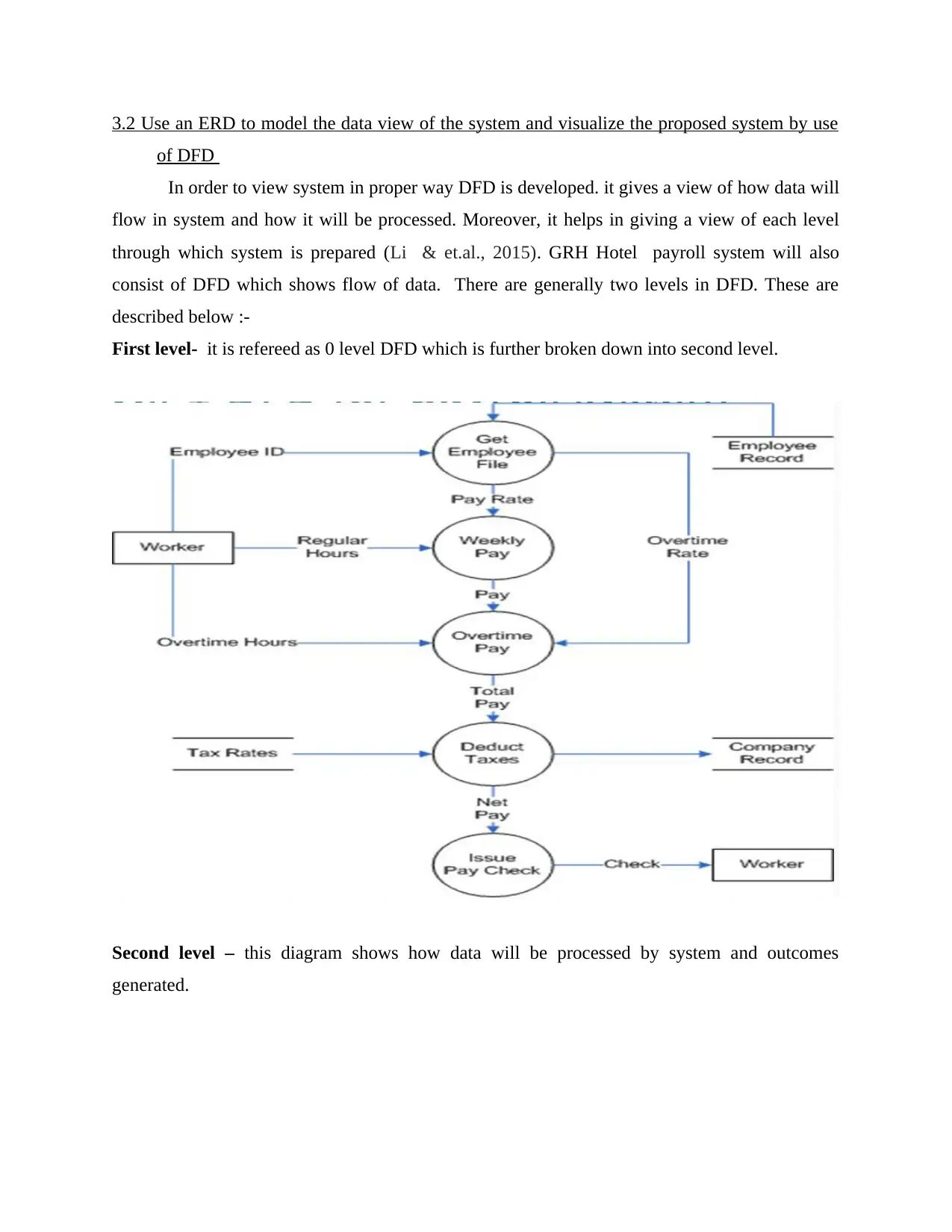
3.2 Use an ERD to model the data view of the system and visualize the proposed system by use
of DFD
In order to view system in proper way DFD is developed. it gives a view of how data will
flow in system and how it will be processed. Moreover, it helps in giving a view of each level
through which system is prepared (Li & et.al., 2015). GRH Hotel payroll system will also
consist of DFD which shows flow of data. There are generally two levels in DFD. These are
described below :-
First level- it is refereed as 0 level DFD which is further broken down into second level.
Second level – this diagram shows how data will be processed by system and outcomes
generated.
of DFD
In order to view system in proper way DFD is developed. it gives a view of how data will
flow in system and how it will be processed. Moreover, it helps in giving a view of each level
through which system is prepared (Li & et.al., 2015). GRH Hotel payroll system will also
consist of DFD which shows flow of data. There are generally two levels in DFD. These are
described below :-
First level- it is refereed as 0 level DFD which is further broken down into second level.
Second level – this diagram shows how data will be processed by system and outcomes
generated.
Paraphrase This Document
Need a fresh take? Get an instant paraphrase of this document with our AI Paraphraser
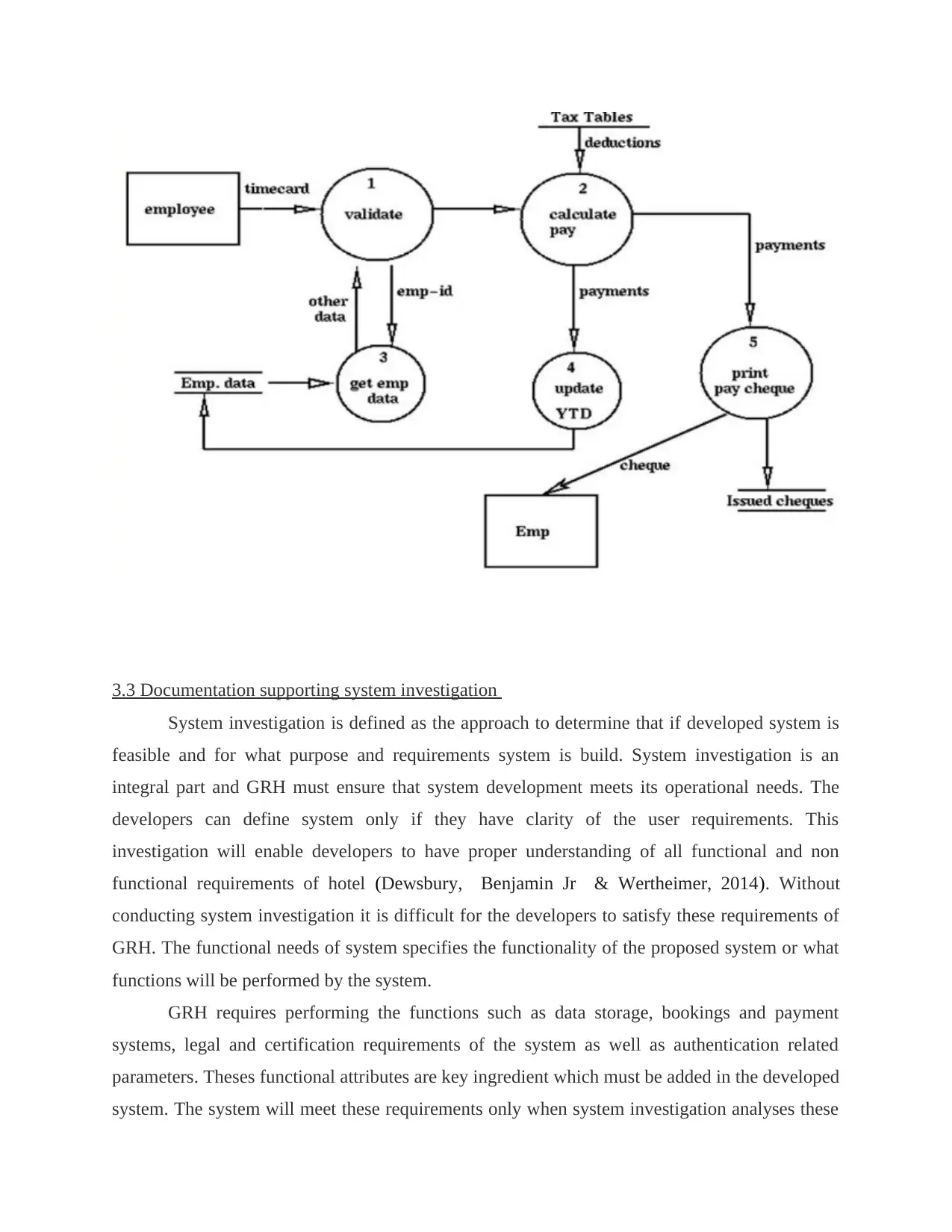
3.3 Documentation supporting system investigation
System investigation is defined as the approach to determine that if developed system is
feasible and for what purpose and requirements system is build. System investigation is an
integral part and GRH must ensure that system development meets its operational needs. The
developers can define system only if they have clarity of the user requirements. This
investigation will enable developers to have proper understanding of all functional and non
functional requirements of hotel (Dewsbury, Benjamin Jr & Wertheimer, 2014). Without
conducting system investigation it is difficult for the developers to satisfy these requirements of
GRH. The functional needs of system specifies the functionality of the proposed system or what
functions will be performed by the system.
GRH requires performing the functions such as data storage, bookings and payment
systems, legal and certification requirements of the system as well as authentication related
parameters. Theses functional attributes are key ingredient which must be added in the developed
system. The system will meet these requirements only when system investigation analyses these
System investigation is defined as the approach to determine that if developed system is
feasible and for what purpose and requirements system is build. System investigation is an
integral part and GRH must ensure that system development meets its operational needs. The
developers can define system only if they have clarity of the user requirements. This
investigation will enable developers to have proper understanding of all functional and non
functional requirements of hotel (Dewsbury, Benjamin Jr & Wertheimer, 2014). Without
conducting system investigation it is difficult for the developers to satisfy these requirements of
GRH. The functional needs of system specifies the functionality of the proposed system or what
functions will be performed by the system.
GRH requires performing the functions such as data storage, bookings and payment
systems, legal and certification requirements of the system as well as authentication related
parameters. Theses functional attributes are key ingredient which must be added in the developed
system. The system will meet these requirements only when system investigation analyses these
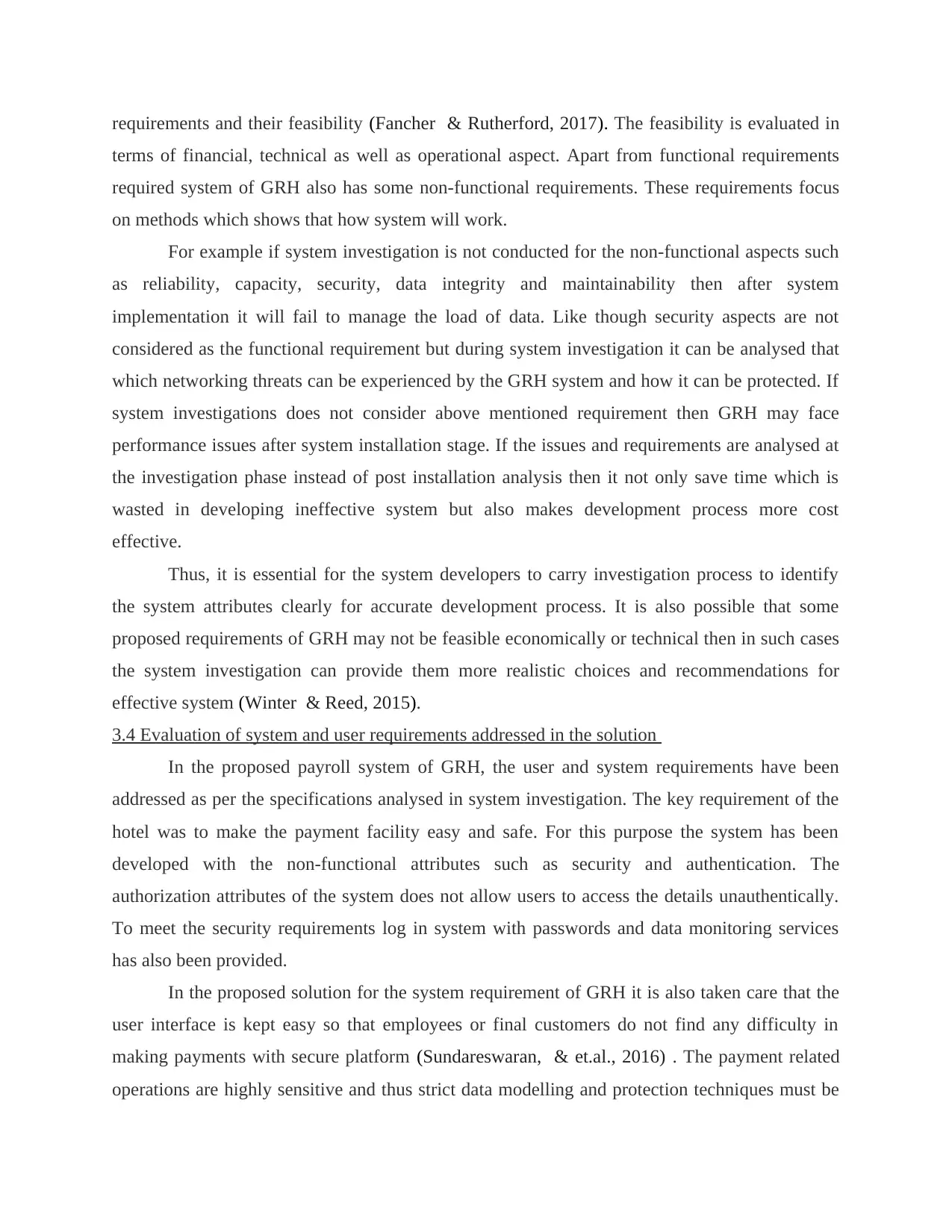
requirements and their feasibility (Fancher & Rutherford, 2017). The feasibility is evaluated in
terms of financial, technical as well as operational aspect. Apart from functional requirements
required system of GRH also has some non-functional requirements. These requirements focus
on methods which shows that how system will work.
For example if system investigation is not conducted for the non-functional aspects such
as reliability, capacity, security, data integrity and maintainability then after system
implementation it will fail to manage the load of data. Like though security aspects are not
considered as the functional requirement but during system investigation it can be analysed that
which networking threats can be experienced by the GRH system and how it can be protected. If
system investigations does not consider above mentioned requirement then GRH may face
performance issues after system installation stage. If the issues and requirements are analysed at
the investigation phase instead of post installation analysis then it not only save time which is
wasted in developing ineffective system but also makes development process more cost
effective.
Thus, it is essential for the system developers to carry investigation process to identify
the system attributes clearly for accurate development process. It is also possible that some
proposed requirements of GRH may not be feasible economically or technical then in such cases
the system investigation can provide them more realistic choices and recommendations for
effective system (Winter & Reed, 2015).
3.4 Evaluation of system and user requirements addressed in the solution
In the proposed payroll system of GRH, the user and system requirements have been
addressed as per the specifications analysed in system investigation. The key requirement of the
hotel was to make the payment facility easy and safe. For this purpose the system has been
developed with the non-functional attributes such as security and authentication. The
authorization attributes of the system does not allow users to access the details unauthentically.
To meet the security requirements log in system with passwords and data monitoring services
has also been provided.
In the proposed solution for the system requirement of GRH it is also taken care that the
user interface is kept easy so that employees or final customers do not find any difficulty in
making payments with secure platform (Sundareswaran, & et.al., 2016) . The payment related
operations are highly sensitive and thus strict data modelling and protection techniques must be
terms of financial, technical as well as operational aspect. Apart from functional requirements
required system of GRH also has some non-functional requirements. These requirements focus
on methods which shows that how system will work.
For example if system investigation is not conducted for the non-functional aspects such
as reliability, capacity, security, data integrity and maintainability then after system
implementation it will fail to manage the load of data. Like though security aspects are not
considered as the functional requirement but during system investigation it can be analysed that
which networking threats can be experienced by the GRH system and how it can be protected. If
system investigations does not consider above mentioned requirement then GRH may face
performance issues after system installation stage. If the issues and requirements are analysed at
the investigation phase instead of post installation analysis then it not only save time which is
wasted in developing ineffective system but also makes development process more cost
effective.
Thus, it is essential for the system developers to carry investigation process to identify
the system attributes clearly for accurate development process. It is also possible that some
proposed requirements of GRH may not be feasible economically or technical then in such cases
the system investigation can provide them more realistic choices and recommendations for
effective system (Winter & Reed, 2015).
3.4 Evaluation of system and user requirements addressed in the solution
In the proposed payroll system of GRH, the user and system requirements have been
addressed as per the specifications analysed in system investigation. The key requirement of the
hotel was to make the payment facility easy and safe. For this purpose the system has been
developed with the non-functional attributes such as security and authentication. The
authorization attributes of the system does not allow users to access the details unauthentically.
To meet the security requirements log in system with passwords and data monitoring services
has also been provided.
In the proposed solution for the system requirement of GRH it is also taken care that the
user interface is kept easy so that employees or final customers do not find any difficulty in
making payments with secure platform (Sundareswaran, & et.al., 2016) . The payment related
operations are highly sensitive and thus strict data modelling and protection techniques must be
⊘ This is a preview!⊘
Do you want full access?
Subscribe today to unlock all pages.

Trusted by 1+ million students worldwide
1 out of 16
Related Documents
Your All-in-One AI-Powered Toolkit for Academic Success.
+13062052269
info@desklib.com
Available 24*7 on WhatsApp / Email
![[object Object]](/_next/static/media/star-bottom.7253800d.svg)
Unlock your academic potential
Copyright © 2020–2025 A2Z Services. All Rights Reserved. Developed and managed by ZUCOL.





